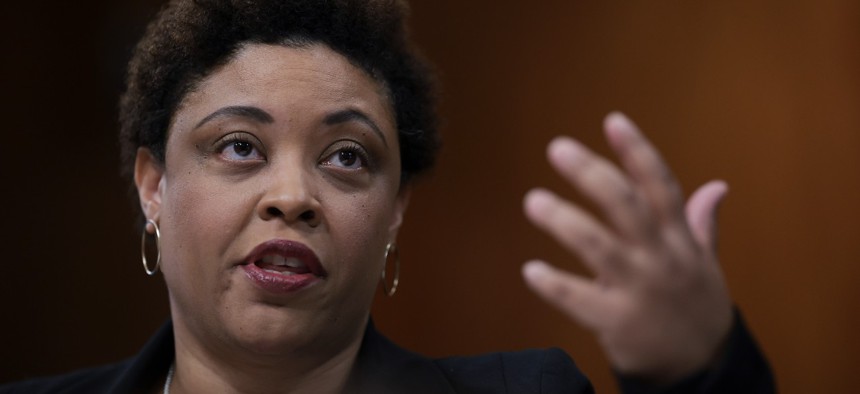
OMB Director Shalanda Young sent the memo. Win McNamee/Getty Images
The Biden Administration Tells Agencies to Scale Back Telework
Federal employee unions and career agency HR leaders reportedly were left out of the development of a new Office of Management and Budget memo that instructs agencies to “substantially increase meaningful in-person work at federal offices.”
The Biden administration on Thursday announced new measures to scale back telework at federal agencies, coinciding with the end of the COVID-19 national emergency and the one-year anniversary of agencies implementing their office reentry plans. The announcement appeared to catch some federal employee groups and agency HR officials off guard.
Although telework and remote work were a significant part of agencies’ continuity of operations during the pandemic, with some agencies reporting enhanced productivity and high employee engagement scores in the federal government’s annual survey of federal worker morale, the workplace flexibilities have increasingly been in the crosshairs of Republican lawmakers, who blame poor customer service at agencies like the Social Security Administration and Internal Revenue Service on the practice. Democrats and employee groups instead point to chronic underfunding and understaffing of these agencies as the root of performance issues.
Office of Management and Budget guidance released Thursday tasks agencies with developing a new system to monitor their “organizational health and organizational performance” on an ongoing basis. With the new system comes an expectation that federal agencies will rely less on telework and remote work, although that must be balanced with the need to compete for talent with private sector employers who continue to offer similar workplace flexibilities, wrote OMB Deputy Director for Management Jason Miller in a blog post accompanying the memo.
“The guidance we are releasing today directs agencies to refresh their work environment plans and policies—with the general expectation that agency headquarters will continue to substantially increase in-person presence in the office—while also conducting regular assessments to determine what is working well, what is not, and what can be improved,” Miller wrote. “Workplace flexibilities will continue to be an important tool for ensuring agencies are able to retain and compete for top talent in the marketplace. Because the federal government is a vast organization, there is no one-size-fits-all approach; however, as a whole, it is important to establish overarching goals and benchmarks for consistency.”
The memo, sent to agency heads by OMB Director Shalanda Young, at various points tries to juggle responding to critiques of telework—both from Republicans and local leaders like Washington, D.C., Mayor Muriel Bowser, who blamed some of the city’s economic difficulties on underutilized government buildings—and preserving the practice as a valuable tool to boost productivity and recruit and retain qualified workers.
“Agency workforces are generally expected to increase meaningful in-person work—that is in-person work that is purposeful, well-planned and optimized for in-person collaboration—while still using flexible operational policies as an important tool in talent recruitment and retention,” Young wrote. “Planning should recognize that some operating units have improved performance while using workplace flexibilities, while also optimizing in-person work and strong, sustainable organization health and culture. Emphasis on planning should be placed on agency headquarters and equivalents and customer-facing units and personnel, including in high impact service providers.”
Agencies should take a holistic approach to measuring the various impacts of telework and remote work on federal agency operations, Young wrote.
“As agencies consider their work environments within their major operating units, assessments of organizational health and organizational performance can help identify beneficial or adverse impacts of telework and other operational policies on the agency’s performance of its mission,” she wrote. “These may include impacts to customer experience and service, security, cost to operations, management of real property, investments in network capacity or communications infrastructure, and the agency’s ability to recruit and retain top talent. Such assessments can also be used to assess technology capabilities, with an eye towards improving efficiency and reducing time spent on processes that rely on outdated technology.”
If agency officials find that policies are impacting their organizational health and performance, Young said they should “rapidly make adjustments” to address poor performance.
Some federal employee groups have taken something of a “wait-and-see” approach to the new guidance. American Federation of Government Employees National President Everett Kelley said he was heartened that OMB recognized that telework has merit in federal agencies, but he stressed that any changes must be negotiated between agency leaders and their corresponding unions.
“As with any change to working conditions, the voices and concerns of the employees directly affected deserve to be heard through the collective bargaining process,” Kelley said. “We look forward to continuing to participate in that process at the appropriate level and reaching agreements that meet the operational needs of federal agencies while protecting productivity gains associated with telework as well as the ability to recruit and retain the next generation of government employees in a competitive labor market.”
And Rep. Gerry Connolly, D-Va., a longtime advocate for enhanced telework in the federal government, applauded the memo, describing the administration’s approach as “thoughtful and deliberate.”
“Agency mission, employee safety, and service to our constituents must be our top priority,” he said. “The pandemic taught us that telework is a valuable and necessary tool for continuity of operations. But it is not and should not be one-size-fits-all. The administration’s balanced guidance recognizes that fact, and puts us on a path toward structured telework programs that are tailored to the specific needs of individual agency missions—as they should be.”
Still, other federal employee organizations said they were blindsided by the memo’s distribution to agency leaders this week. International Federation of Professional and Technical Engineers National President Matt Biggs said that given President Biden’s focus on collaborative labor-management relations, he was surprised that unions were not given an opportunity to weigh in on the policy before its announcement.
“It’s pretty disappointing,” he said. “This is a pro-labor president, but for OMB to unilaterally move forward and put this together in what appears to be a hasty manner without even so much as a heads up, much less the involvement of labor, is extremely disappointing.”
And Jason Briefel, executive director of the Senior Executives Association, said many career HR leaders were caught unawares by the news that the White House was preparing to release a memo that appears to reduce telework in the federal workforce.
“I am hearing people are very surprised and that career staff were not involved or consulted,” he said. “[Chief human capital officers] were not consulted or including in the drafting of the memo. You know, the professionals who are supposed to advise and lead on this stuff, in addition to [the Office of Personnel Management].”







